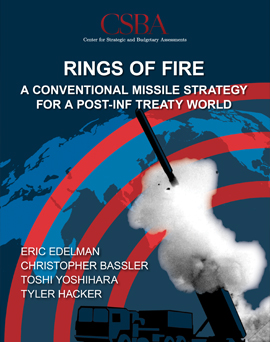
Since its withdrawal from the Intermediate-Range Nuclear Forces (INF) Treaty in 2019, the United States has been free to develop new medium and intermediate-range conventional missiles to strengthen its conventional deterrence posture. The military services have tested and fielded a variety of systems that could bolster their long-range strike capabilities and proposed still others. To date, however, Washington lacks a clear path for how the various service initiatives might contribute collectively to a broader precision-strike complex.
Following the U.S. withdrawal from the INF Treaty, many studies have discussed what sorts of conventional missiles the United States might now include in its portfolio. In Rings of Fire: A Conventional Missile Strategy for a Post-INF Treaty World, authors Eric Edelman, Chris Bassler, Toshi Yoshihara, and Tyler Hacker instead discuss how the United States will incorporate intermediate-range conventional missiles into its deterrence posture, and which allies and partners are closely linked to this strategy. With an eye toward the Indo-Pacific in the near term and Europe farther off, the authors propose an analytical framework based on the different ranges of U.S. and adversary missile capabilities, the geostrategic landscape, and the asymmetries in platforms and geography. From this framework, Rings of Fire then compares the current array of U.S. and allied assets in both regions with proposed capabilities to formulate a new missile strategy. The study concludes with an examination of multiple independent reentry vehicles (MIRVs) and maneuverable reentry vehicles (MARVs) within a conventional missile strategy and their respective utility in both theaters.



























